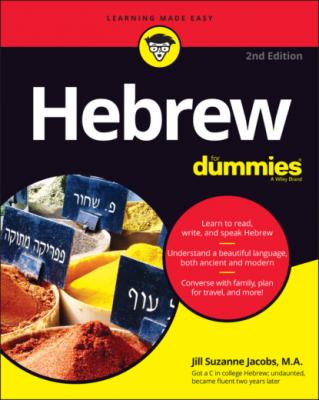Hebrew For Dummies. Jill Suzanne Jacobs
Читать онлайн.| Название | Hebrew For Dummies |
|---|---|
| Автор произведения | Jill Suzanne Jacobs |
| Жанр | Иностранные языки |
| Серия | |
| Издательство | Иностранные языки |
| Год выпуска | 0 |
| isbn | 9781119862048 |
אֶת פָרֶאד נִשְׁקָהּ מָלִי (eht fred neesh-kah moh-lee; Fred [is] kissed [by] Mollie.)
All these sentences, despite their different word order, mean essentially the same thing: Mollie kissed Fred.
יֵשׁ בָּנָנוֹת (yehsh bah-nah-noht; There are bananas.)
אֵין בָּנָנוֹת (ayn bah-nah-noht; There aren’t any bananas.)
Now, you can find any noun in this book, put a יֵשׁ or an אֵין in front of it, and you’ll be speaking Hebrew!
Questioning
When you make a question, you don’t change the order of the words, as in English. You can ask a question in a few ways. The first way is by simply taking a statement and putting a question mark in your voice (by raising your voice at the end of the sentence). Thus, when asked with the proper intonation, this statement can be a question: ? יֵשׁ חָלָב בַּמְּקָרֵר (yesh haḥ-lahv bah-mahk-rehr?; There’s milk in the refrigerator?).
Another way to turn this statement into a question is to add the word נָכוֹן (nah-chohn; correct) to the end of the statement. In grammarspeak, this word is called a tag. For example:
? יֵשׁ חָלָב בַּמְּקָרֵר נָכוֹן (yehsh chah-lahv bah-mahk-rehr, nah-chohn?; There’s milk in the refrigerator, correct?)
Yet another way to turn a statement into a question is to add the question word, הַאֵים (hah-eem), in front of the sentence — for example ? הַאֵים יֵשׁ חָלָב בַּמְּקָרֵר (hah-eem yehsh chah-lahv bah-mahk-rehr; Is there milk in the refrigerator?). This last option is the most formal option, so you won’t hear it often.
Although Hebrew differs from English in that you don’t need to flip the order in a statement to turn it into a question, the word-order flexibility of Hebrew allows the speaker to stress a particular part of the sentence by putting it at the beginning.
If someone just said there are no strawberries in the fridge, for example, you might ask ? יֵשׁ בָּנָנוֹת(yesh bah-nah-noht; literally: Bananas?; But are there bananas?). Or you might ask ? אֵין בָּנָנו(ehn bah-nah-noht?; literally: Bananas there aren’t?; Aren’t there bananas?).
Recognizing Parts of Speech
In Hebrew, you can recognize the different parts of speech — such as nouns, verbs, and adjectives — by their distinct patterns. Sometimes, however, a word is both a verb and a noun, and adjectives and adverbs can take on many forms, so I can’t offer any easy clues for distinguishing the various parts of speech. You just need to memorize the vocabulary; then you’ll know.
Naming nouns
In Hebrew, all nouns are either masculine or feminine. They’re conjugated according to number (singular and plural). The noun book (a masculine noun), for example, can be conjugated two ways:
סֵפֶר (seh-fehr; book)
סְפָרִים (sfah-reem; books)
Look at this example of a feminine noun:
מַזְלֵג (mahz-lehg; fork)
מַזְלְגוֹת (mahz-leh-goht; forks)
Check out Table 2-1 for some common Hebrew nouns.
TABLE 2-1 Identifying Some Common Nouns
| Hebrew | Pronunciation | Translation |
|---|---|---|
| בַּיִת | bah-yeet | house |
| דֶּרֶךְ | deh-rech | way, road |
| אִישׁ | eesh | man |
| אִשָּׁה | ee-shah | woman |
| כֶּסֶף | keh-sehf | money |
| מַפְתֵּחַ | mahf-teh-ach | key |
| מַגֶּבֶת | mah-geh-veht | towel |
| מְקָרֵר | mahk-rehr | refrigerator |
| מַזְגָן | mahz-gahn | air conditioner |
| מַזְלֵג | mahz-lehg | fork |
| מְכוֹנִית | meh-hoh-neet | car |
| מִהְבָּח | meet-bahch | kitchen |
| מִבְרֶשֶׁת | meev-reh-sheht | brush |
| אֹכֶל | oh-ḥehl | food |
| סֵפֶר | seh-fehr | book |
|
שֶׁמֶשׁ
|
